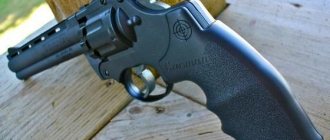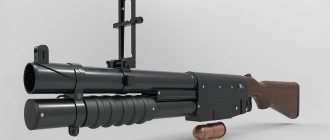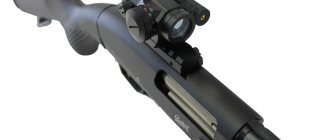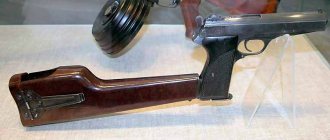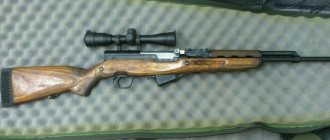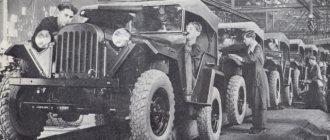Weapons such as bows and arrows have been used since ancient times. But it took many years to train a good archer. That is why people invented new devices to speed up the learning process. Archers had a gastrafet built, which contained a special apparatus for tensioning the bowstring and releasing the arrow. Thanks to this mechanism, the process has become much more convenient and faster. Over time, it became the most sought-after type of weapon, but the characteristics of the medieval crossbow were constantly changing to improve. The device became popular when defending a castle, because the firing range made it possible to keep enemies at a great distance. And since iron bolts were used instead of a regular arrow, there was practically no protection for him. Gradually, these weapons spread throughout the entire Earth. The types have changed, but the principle of operation has always remained the same. In the Middle Ages, this weapon was very popular in Western Europe during the Crusades.
Unlike a conventional bow, a crossbow has a great advantage: the device is triggered when the shooter presses the trigger, thereby increasing the range and power of the shot.
Medieval crossbow
The first historically confirmed data on crossbows dates back to 400 BC. According to one version, China is considered its homeland, according to another - Greece. It can be assumed that the combat crossbow appeared in both the East and the West at approximately the same time.
Ancient crossbow: replica.
In medieval Europe, the crossbow reached its peak of popularity in the 12th to 16th centuries. When defending castles, it was a more effective weapon than a bow. The chronicles of those years describe the battles of English, French, German and other troops, in which the crossbow is mentioned.
The first guns had a very simple design and short range. They were made of wood. Only a warrior unprotected by armor could be hit with an arrow fired from such a crossbow. Over time, the design has undergone improvements. When making weapons, animal tendons, horns, and metal were used.
Starting from the 12th century, special belt hooks began to be used to tighten the bowstring. This made the difficult task easier for the shooter. goat’s leg came into use - a lever that catches the bowstring. The crossbowman pulled the lever towards himself, and the bowstring tightened.
Crossbow arrows were different from bow arrows. They were more massive, heavier, and had tetrahedral tips.
With the advent of firearms, the crossbow gradually lost its relevance, but it has not yet been possible to completely supplant it.
https://youtu.be/zWlFASPc1-A
New in blogs
There have been many discussions, articles, books and studies about the crossbow - historical and not so much. A huge number of legends, true and fictional, are associated with this weapon. We will try to bring a little clarity to all this confusion, to isolate the truth from the mass of data. If anyone has more reliable information, please share.
Origin
One of the earliest references to a crossbow-like mechanism, the ballista, can be found in the Bible. However, crossbows were used even earlier - in East Asia. The oldest specimen dates back to approximately the fifth century BC. It was produced in China in fairly large quantities - for its own troops, as well as for foreign mercenaries.
The crossbow was so popular due to its cost, as well as the speed of training soldiers to use this weapon. For example, much later, in England they began training archers from early childhood: in order to train accuracy and back muscles. They even liked to say here: “if you want to learn an archer, start with his grandfather.” Of course, this is a completely different era. However, comparing a bow with a crossbow is quite revealing.
After all, a crossbowman can learn in a really short time. He doesn’t need to train very strong muscles: after all, the levers are with stirrups. It is also curious that crossbows were almost invariably given out on some type of lease for the duration of the nobles' service. The rent was relatively low. Such troops could be recruited and mobilized simply and quickly.
Pros and cons of a crossbow
Naturally, this weapon, like any other, has significant drawbacks. First, we are talking about the time to draw the bowstring or cowhide in the case of a thousand-pound model. The prices for both the crossbow and the tool that pulls the bowstring are high.
In bad weather, power is lost quite quickly because the bowstring, like the skin, stretches. Crossbowmen were forced to carry several bowstrings under the cape at once to ensure tension. But the crossbow itself is quite heavy.
A crossbow bolt quickly loses impact at a distance because its mass is small. The shooter is vulnerable to return fire because it takes a long time to draw the arrow - without any natural cover.
However, this weapon also has its advantages. At short distances its penetrating ability is great. To kill an enemy, you do not need to break through armor. Yes, this is unrealistic if the quality of the armor is average or above average. Even if the tension force exceeds a thousand pounds.
You can shoot from any position, not just sitting. Studying, as already mentioned, does not require much time. A person of any build can use this weapon. After all, there are levers, as well as other mechanisms that tighten the bowstring. Over short distances the bolt flies at a decent speed.
The most popular myths
The nobles hated crossbows - and at the same time their owners
Perhaps - but until she herself tested them against each other, and quite effectively. Over time, even the payment for their service exceeded the prices of archers. There are cases where they paid very well just for participating in the tournament: 157 pounds with a daily payment of eight pence per person.
In the Middle Ages, the Catholic Church prohibited the use of crossbows in Christian wars.
This is only partly true. Now, in theory, bows with a draw weight of a hundred pounds are also prohibited. This decision was made by Pope Innocent II back in 1139. The nobility put pressure on him, since this device was dangerous for the knights, whom the chain mail could no longer save from the bolts. As they say, crossbows were prohibited, since an ordinary peasant who practiced shooting for one day could cripple and mortally wound a knight. But the latter had been trained to maim and wound all his life.
We are talking about the first half of the twelfth century, when a new development called “brigandine” was just being created. So the crossbow still brought real terror to the knights. Don't forget about people subordinate to vassals and knights. Throughout the Middle Ages, wars were won primarily by the peasants, who were supported by mounted troops. Naturally, these poor fellows did not have the money for expensive chain mail and armor in those days. As a result, there was a significant mortality rate from this terrible weapon, which could not but irritate the knights.
As a result, the servants of God did not care about their own past indignations, using the same weapons against both infidels and other subordinate enemies of this or that landowner. The nobility especially did not care about the opinions of the church. She hired crossbowmen to do incredible things to her opponents on the battlefield.
In the Middle Ages, the crossbow was an advanced weapon
This statement is more likely to apply to China in the fifth century before our era. But, despite the fact that the crossbow ceased to be advanced by the beginning of the Middle Ages, it was still quite effective at that time. Subsequently, it became obsolete on the battlefields, and was used mainly during sieges. At the Battle of Crecy he performed poorly, especially against the English true longbow.
The latter consistently destroyed both mercenaries and nobles: at a speed of up to ten blows per minute. Crossbowmen could achieve a similar rate of fire of seven to eight strikes per minute only by hiring a couple of servants. One of them pulled the bowstring, while the second moved the paveza.
The crossbow was the impetus for the decline of chivalry
There are many arguments against this theory, which are too long to list. We will speak to the point. Chivalry disappeared for the following reasons:
• too expensive to maintain;
• appearance of gunshots;
• changing tactics with the strategy of fighting in connection with the same firearms: after all, armor did not save from them.
The armor of the knights was penetrated by heavy crossbows
It's not like that at all. There is actually one video in support of this version about San Marino crossbowmen. However, even if you change the shape of the tip and get a weighty bolt, the penetration of the armor will be one and a half to two centimeters. This is not at all scary for a person wearing this armor, because the gap between the visor or breastplate and the body is quite large. In addition, this particular type of crossbow in armor has not been tested.
There are tests with more popular models of crossbows and surface-hardened armor. On one of them, the bowstring tension (claimed) was a thousand pounds, but the real one was 900 pounds. Weather conditions completely reduced it to 750 pounds. No less important is what kind of tip it was. The slow-witted version used in the test could have killed thanks to the power of the blow.
For example, experts conducted experiments that showed that a 140-pound longbow was comparable in impact force to a magnum shot. Just think of the force of a nine-hundred-pound crossbow bolt on your legs, armor, or helmet. Such a monster could easily break through shields, and after them, the bodies or faces of people at medium and close distances.
In the finale it is worth talking a little about the daily work of the already mentioned crossbowmen. There were no formal rifle formations. The detachments were recruited from ordinary soldiers, if they had the actual mechanisms and suitable bolts. Typically, as necessary, crossbowmen retrained as archers and vice versa. In the first half of the fifteenth century they received eight pence daily. The rate for horse archers was six pence, for cavalry - fifteen pence. Original taken from nathoncharova in History of the Crossbow. Also: popular misconceptions and facts
The design and principle of operation of a crossbow
A crossbow is a bow mounted on a stock (base) and equipped with additional mechanisms for tensioning the string, releasing the trigger, and aiming.
The principle of operation has remained unchanged since ancient times.
- The cocked bowstring is fixed in the lock, and an arrow (bolt) is placed in the stock guide.
- The shooter takes aim, pulls the trigger, releasing the bowstring.
- The arcs straighten, and the bowstring forcefully pushes the arrow towards the target.
Device:
- The stock is the base to which all parts of the device are attached. Made from wood, plastic, metal. The stock also has a guide for the crossbow bolt.
- Shoulders – arcs to which the bowstring is attached. They accumulate mechanical energy for firing. Material for production: wood, metal. In ancient times, tendons and horns of cattle were also used.
Crossbow: device. - The trigger mechanism ensures retention and release of the bowstring. On simple devices it can be in the form of a wooden trigger. On more complex models, a cased metal trigger mechanism is installed.
- A bowstring is a rope made of strong threads or metal attached to the shoulders. In places of friction on the bowstring, a braid is made. Modern string threads are Kevlar, Dacron, Dacron. Metal cables are also used.
- A block or cross is a fastening for arcs. It experiences heavy loads, so it is preferable to use high-strength steel as the material for its manufacture.
- Sights – ensure shot accuracy. There are optical, dioptric and open.
Sighting optics
Factory optics from firearms can be used as a crossbow sight. A fairly practical solution is to use a front and rear sight. Using the latter, you can make vertical corrections. It is convenient to make horizontal adjustments using a front sight mounted at the intersection of the shoulders and the stock.
To ensure ease of transportation of the crossbow, it is worth making the sighting device removable. To do this, you can install a so-called Picatinny rail on the weapon, which makes it possible to mount individual factory-assembled sights.
Types of crossbows for hunting
The preferred types of crossbows for hunting depend on the preferences of the shooter and the conditions in which it will be used.
If this is a short-term trip, then a compact compound crossbow is quite suitable. If this is a long hike, then you should give preference to the reliability of recursive weapons.
There is an opinion that a compound crossbow is better than a recurve crossbow because it is more powerful and has a faster rate of fire. But this is a controversial proposition.
When compared, it is clear that both devices have sufficient arrow speed for use in hunting.
Recursive
A recurve crossbow is the very device that the average person imagines when they hear the word “crossbow.” Its shoulders bend in the direction opposite to the pull and are connected by a bowstring.
When cocked, the bowstring bends its arms, increasing the tension force until it locks into the trigger mechanism. At this moment the castle is under the greatest load. When fired, the bowstring is released, transferring the energy of the arcs to the projectile.
Features of the recurve crossbow:
- Thanks to the lightness of the shoulders, the device is lightweight, and the center of gravity is shifted to the butt. This makes it easier to aim and fire.
Recurve crossbow. - Simplicity of design ensures reliability. They are less likely to fail because they have a minimum of parts.
- No block settings required.
- Easy to maintain.
- They have wider dimensions compared to block ones, which can make transportation difficult.
- With the same tension values in the block and recurve devices, in the recurve device the arrow has a lower take-off speed.
Blocky
In a block crossbow, there are special blocks at the ends of the arcs, onto which cables are wound when the bowstring is pulled. These cables bend the shoulders and distribute the load so that the lock bears about a third of it. When the bowstring is released, the blocks rotate, giving the arrow additional acceleration.
Peculiarities:
- High power with little effort.
Block crossbow. - Compact dimensions.
- The lock is not subject to overload, the descent is carried out gently.
- Thanks to the blocks, it is easier to tighten the bowstring.
- The center of gravity is slightly shifted towards the shoulders, which can make aiming difficult.
- They have a complex structure and therefore require more thorough repairs. It is impossible to repair such a device “on the knee”.
- Requires special block settings.
Main selection criteria
First of all, you need to decide for what purpose the weapon is being purchased. Hunting crossbows must have high destructive power. For sports shooting, models with high accuracy are preferred. For entertainment and study purposes, inexpensive, lightweight devices with average performance are quite suitable.
When choosing, you should pay attention to the following indicators:
- Power or tension force. Devices with a capacity of no more than 43 kg are allowed on the territory of the Russian Federation.
- Bowstring stroke. The greater the distance between the bowstring in the free position and in the tension, the greater the power and range of the shot.
Crossbow. - Convenience . The weapon should be comfortable to use, as light as possible.
- Availability of parts. You need to ask if there are spare parts for the selected weapon on sale, so that if necessary, you can replace a broken part. Otherwise, you will have to buy a new crossbow.
- Availability and cost of ammunition. Arrows are a consumable item, so it is worth asking about their price.
Lodge
To make the part, you can use an easily processed wooden blank in the form of a board about 30 mm thick. It is worth noting that, despite the high strength indicators, oak is not very suitable for these purposes due to its significant weight. As for spruce and pine, the latter are not sufficiently resistant to mechanical damage and warp when in contact with moisture. Therefore, the type of wood should be selected depending on the goals and conditions of future use of the crossbow.
How to make a hunting crossbow truly practical? During manufacturing, special attention should be paid to the guide in the form of a groove for the arrow, which you should try to make as even, smooth and polished as possible. The condition of the groove largely affects shooting accuracy
It is advisable that the width of the stock be equal to the diameter of the arrows used. You can cut it using a circular saw.
It is rational to use a spring as a means of holding the arrow, which will press the projectile to the stock and will not allow the latter to slip out of the groove before firing.
Safety precautions
A crossbow is a dangerous weapon. In order to protect yourself and others, you must adhere to the following safety rules:
- A crossbow with a drawn bow is considered loaded.
- It is prohibited to fire blank shots.
- Before shooting, it is necessary to check all components of the weapon and the condition of the arrows.
- It is forbidden to keep your finger on the trigger until aiming.
- It is prohibited to talk, be distracted, or move while aiming and shooting.
- It is prohibited to transfer a loaded crossbow.
- The line of fire must be clear of people and animals. You need to make sure that if you miss, the arrow will not hit a live target.
- It is prohibited to shoot upward.
- Do not leave unattended, especially within the reach of children.
- The weapon must be stored unloaded.
- Do not touch the stretched bowstring
- Safety glasses should be used.
How to shoot a crossbow correctly
Sequencing:
- Manufacturing.
- Breath control.
- Aiming.
- Shot.
Shooting positions:
- Shooting while standing. The shooter's left side is turned towards the target. The main support is the legs. They are shoulder-width apart, the weight is distributed evenly on both legs. The right hand holds the butt, the left holds the stock. Your back should be slightly tilted back for balance. The head is turned in the direction of shooting, held straight.
- Shooting with support on the knee. The support is the right knee and the feet of both legs. The left shin should be vertical to the ground. The elbow of the leading hand rests on the left knee, the right hand holds the butt.
- Prone shooting. The most stable position, the whole body serves as support. The legs are relaxed and spread apart for stability, the right one is slightly bent. The left hand, holding the forend, is half-bent and extended forward, the right hand holds the butt, the elbow touches the shooting line.
In each position, the butt rests against the right side of the sternum at the collarbone. To avoid injury, you should be aware of recoil after a shot.
Shooting while standing.
Kneeling shooting position.
